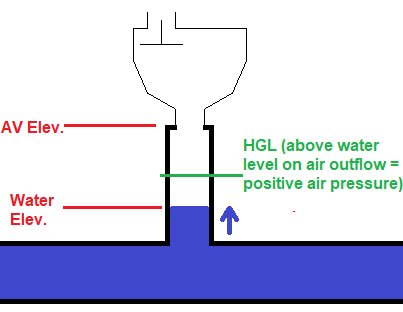| Product(s): |
HAMMER |
| Version(s): |
CONNECT Edition |
| Area: |
Calculations |
Problem
When examining air valve results (air head and free air flow rate in the Extended Node Data tab of the Transient Results Viewer) you may notice that the air outflow is positive at times during which the air valve pressure is negative (air head / hydraulic grade is below the air valve elevation).
Solution
This condition is possible because of the drop in water level inside the air valve. Meaning, the hydraulic grade shown in the results at an air valve is actually the water level inside the air valve, not the hydraulic grade resulting from air pressure.
When the pressure first becomes negative at an air valve during a transient simulation, air begins to enter the air valve and the water level drops. This is seen as a negative pressure when the hydraulic grade line drops below the air valve elevation. When the water level starts to rise again (as depicted in the illustration below), the air pocket can become compressed (positive air pressure) causing air outflow to occur even though the reported hydraulic grade (water level) is below the air valve physical location. So, the actual hydraulic grade is above the reported hydraulic grade (see green line below), and the air pocket pressure is actually based on the difference between them (green line below minus the water elevation line). This is why air outflow can occur even if the hydraulic grade ("air head", which is really the water level) is below the air valve physical elevation.
A future version of HAMMER may enable the user to see the actual air pressure result, which can be helpful to compare to a custom air flow curve for example (enhancement # 728436)

See Also
Modeling Reference - Air Valves